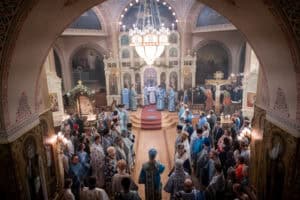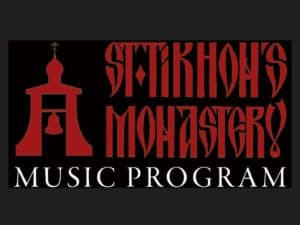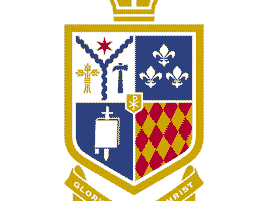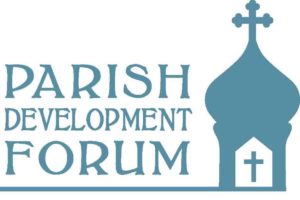FARGO, ND [DOM] – On Tuesday and Wednesday, February 7 and 8, more than 30 faithful and clergy from parishes across North Dakota and northern Minnesota, representing three jurisdictions – the Orthodox Church in America, Serbian Orthodox Church and Antiochian Orthodox Church – convened for a Summit Conference with the blessings of His Eminence, Archbishop Daniel of Chicago and the Diocese of the Midwest, and Diocesan Chancellor, Archpriest Paul Jannakos, in the nave of Holy Resurrection Church, Fargo, ND. “Are the Dakotas a Field Ripe for Harvest? Crafting a Strategic Vision for Evangelizing the Dakotas” was the purpose that brought them together.
This evangelical initiative is under the omophor of Archbishop Daniel. At his direction, the Summit was organized by the Minneapolis District Dean, Archpriest Paul Wesche, together with Priest William Rettig, rector of Holy Resurrection in Fargo, Priest Athanasius Oweis, priest-in-charge of St Basil the Great Antiochian Orthodox Mission in Bismarck, ND, and Archpriest Paul Hodge, who, on behalf of the Minneapolis Deanery, is serving St Peter the Aleut Church in Minot, ND. Both Fr Paul Hodge and Fr Athanasius are in the Antiochian Archdiocese. Their full engagement in the Summit itself and in the evangelical initiative that it has launched, is with the full blessing of their respective hierarchs.
Other clergy participating in the conference were Archpriest Richard Flom and his wife, Matushka Cassiana, serving the Bemidji, MN Chapel in their retirement, Priest Andrew Jaye, serving Holy Myrrhbearers Mission in St Cloud, MN, and Priest Constantine Franck and his wife, Popadija Xenia, serving St Basil the Great Serbian Orthodox Church in Chisholm, MN. Dn Dana Bichler, serving Holy Myrrhbearers in St Cloud, and Dn James Ferrenberg and his wife, Matushka Susan, serving Holy Resurrection in Fargo, were also present. Fr William Rettig’s wife, Matushka Jillian, great with child number four, also was able to join the gathering.
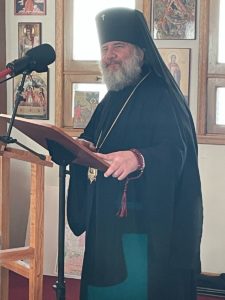 The Summit took place in the nave of Holy Resurrection Orthodox Church to emphasize that the business set before the participants was sacred, and that they were accountable to Our LORD Jesus Christ, His Holy Mother, and His saints. In the nave, the Summit proceeded under the icons, their lampadas lit, to remind everyone that the saints were mystically present in the Cloud of the Lord’s Holy Spirit surrounding them.
The Summit took place in the nave of Holy Resurrection Orthodox Church to emphasize that the business set before the participants was sacred, and that they were accountable to Our LORD Jesus Christ, His Holy Mother, and His saints. In the nave, the Summit proceeded under the icons, their lampadas lit, to remind everyone that the saints were mystically present in the Cloud of the Lord’s Holy Spirit surrounding them.
The idea of a Summit to craft a strategic vision for evangelizing the Dakotas was sown at the Diocesan Assembly of the Midwest held in Baltimore last July, before the convening of the OCA’s All American Council. The Minneapolis District Dean, in his report to the Assembly, stated: “I believe the entire state of North Dakota is a ‘field ripe for harvest.’ With a good strategy, the whole of this ‘Northern Lights’ territory could be an adventure in evangelism. As I envision the possibilities of this evangelical opportunity, I see it presenting rewarding and meaningful experiences that would far outweigh all the challenges such an adventure would bring. Our hierarch, Archbishop Daniel, and the Bishop’s Council have only begun to look at this field ripe for harvest, and have begun piecing together what for now is but a ‘pipe dream’ that would surely be a competitor for any contest of thinking outside the box. The pipe dream is still way up in the sky; but we have begun talking, to consider all that would need to be done to incarnate this dream firmly in the flesh on the ground.” To bring the “pipe-dream” into focus, and “to incarnate it in the flesh firmly on the ground,” was the task the Summit participants were given to accomplish.
As the Dean’s report in July indicated, the original field of vision was North Dakota. But, unexpected events and encounters – mere circumstance or signs from on high? – persuaded the Summit organizers to expand the original vision to include South Dakota and the ‘North Star’ fields of Minnesota as well. And so, invitations to the Summit went out to clergy and faithful in South Dakota and northern Minnesota. In addition to Fr Richard from Bemidji, MN, and Fr Dean and his wife, Papadija Xenia, from Chilsholm, MN, already named above, laity from the OCA Chapel in Bemidji, MN also responded to the invitation and attended the Conference.
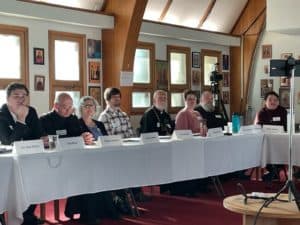 “Surely,” the district dean continued in his opening remarks, “the question that launches the convening of this conference, ‘Are the Dakotas a field ripe for harvest?’ is not our own. It comes from Our Lord Himself: ‘Lift up your eyes and look at the fields, for they are already white for harvest! [Jn 4.35] What is significant, I suggest, is that we are now setting the question squarely before us. Our ‘yes’ in answer to the question is based on the experience and observations of those who live and who are serving in these fields. Our gathering together for this conference signifies, I trust, that we feel we may be ready now in all seriousness to take up the Lord’s Great Commission here in this part of His creation and offer to the Lord our best effort to obey His command, and to go out into the Dakotas to teach His commandments to those who will listen, to raise them from death to life in the waters of the Church’s Holy Baptismal Font. Our desire is to give to them what we have received: not a message, not programs, but the most pure Body and most precious Blood of the only-begotten God incarnate Himself, that they may become, with us, ‘partakers of the divine nature.’”
“Surely,” the district dean continued in his opening remarks, “the question that launches the convening of this conference, ‘Are the Dakotas a field ripe for harvest?’ is not our own. It comes from Our Lord Himself: ‘Lift up your eyes and look at the fields, for they are already white for harvest! [Jn 4.35] What is significant, I suggest, is that we are now setting the question squarely before us. Our ‘yes’ in answer to the question is based on the experience and observations of those who live and who are serving in these fields. Our gathering together for this conference signifies, I trust, that we feel we may be ready now in all seriousness to take up the Lord’s Great Commission here in this part of His creation and offer to the Lord our best effort to obey His command, and to go out into the Dakotas to teach His commandments to those who will listen, to raise them from death to life in the waters of the Church’s Holy Baptismal Font. Our desire is to give to them what we have received: not a message, not programs, but the most pure Body and most precious Blood of the only-begotten God incarnate Himself, that they may become, with us, ‘partakers of the divine nature.’”
Introducing His Eminence to the Summit participants (this was Archbishop Daniel’s first visit to Fargo and to the Dakotas; most of the participants had not met him) the district dean said: “The presence of His Eminence and that of our Chancellor, Fr Paul Jannakos, says that the stewards of the Church’s mysteries are not regarding the Dakotas as a backwater. There are people in this sacred land, hungry and thirsty for meaning, for beauty, for truth, for joy, for blessed immortality that only the Church can give and make incarnate here and now. It is now the intentioned desire of all of us to bring them to drink from the Fountain of Immortality that flows from the altar of the Holy Orthodox Church.”
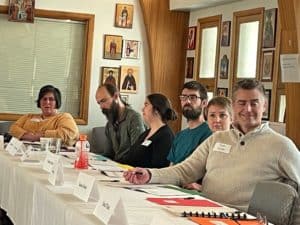 Under the general rubric: “What exactly do we mean by evangelizing?” the sessions of the first day were given to bringing the ‘pipe-dream’ into focus. Following opening remarks by His Eminence, each of the three priests from the three parishes in North Dakota – Fargo, Minot, Bismarck – shared what they saw was needed in order to serve and evangelize their respective regions effectively in the way of the Church. After each presentation, there was discussion by the participants in response to the material presented. Fr William of Fargo presented and elaborated on the evangelical values of presence, relationship, and commitment. He noted that historically, in North Dakota, the common thread running through the several parishes that have not survived over the years was the lack of a consistent priestly presence.
Under the general rubric: “What exactly do we mean by evangelizing?” the sessions of the first day were given to bringing the ‘pipe-dream’ into focus. Following opening remarks by His Eminence, each of the three priests from the three parishes in North Dakota – Fargo, Minot, Bismarck – shared what they saw was needed in order to serve and evangelize their respective regions effectively in the way of the Church. After each presentation, there was discussion by the participants in response to the material presented. Fr William of Fargo presented and elaborated on the evangelical values of presence, relationship, and commitment. He noted that historically, in North Dakota, the common thread running through the several parishes that have not survived over the years was the lack of a consistent priestly presence.
Fr William’s insights would be confirmed by Fr Athanasius later in the afternoon when he would say in his presentation to the Summit, not knowing beforehand the content of Fr William’s presentation: “No sort of evangelization of the Dakotas will ever take place without the presence of clergy that are dedicated to this region. Without dedicated full-time clergy, Orthodoxy will stay stagnant here.”
 Fr Paul Hodge, serving St Peter the Aleut in Minot, followed Fr William and laid out the process for creating and executing a ‘strategic vision for evangelizing the Dakotas.’ The framework that Fr Paul set before the participants would guide their work of rendering the ‘pipe-dream’ incarnate on the following day (Wednesday), when the conference would continue under the general rubric: “Organic ways (i.e., ways most natural to the soul made in the image and likeness of God) to sow the seed of Orthodoxy in the Dakotas.”
Fr Paul Hodge, serving St Peter the Aleut in Minot, followed Fr William and laid out the process for creating and executing a ‘strategic vision for evangelizing the Dakotas.’ The framework that Fr Paul set before the participants would guide their work of rendering the ‘pipe-dream’ incarnate on the following day (Wednesday), when the conference would continue under the general rubric: “Organic ways (i.e., ways most natural to the soul made in the image and likeness of God) to sow the seed of Orthodoxy in the Dakotas.”
The final presentation by Fr Athanasius of the Bismarck mission was read by the district dean, Fr Paul Wesche since Fr Athanasius was unable to attend the conference. Fr Athanasius’ presentation included remarks by Bobby Grey Eagle, a catechumen of the Bismarck mission. Bobby Grey Eagle also was unable to attend the Summit because of prior obligations; his remarks were recorded on a YouTube video that was projected onto a large screen for the Summit participants to view.
Fr Athanasius and Bobby Grey Eagle stressed the inclusion of Native Americans, the peoples of the “First Nations,” in the ‘field ripe for harvest.’ In the words of Fr Athanasius that reminded the participants of the original Orthodox mission to the native Aleuts in Alaska: “We cannot talk about evangelizing the Dakotas without considering the actual Dakota natives, namely, the Seven Tribes of the Sioux Tribes council, and mainly the Dakota and the Lakota Tribes. These tribes have been served for more than 150 years by many other church denominations. They have received plenty of financial and man-power support from many churches. But to the natives, those churches are preaching “the white-man religion”. Orthodoxy is different for them. Because it resembles most of the Native Americans’ worship and, like theirs, is visual, sensory, and reverent, and hierarchical, Orthodoxy is exciting to them and relates strongly to them. Their faith in ‘Creator God’ is easily baptized into Holy Orthodoxy if the proper steps and measures are taken. Our first Lakota catechumen, Moses (Chaska), was received into the Orthodox Faith last October, and we have another Catechumen, Mr. Bobby Grey Eagle, who is sharing an important video about this matter. But for us, these people are not only our brothers; these are the people that have been sitting in the darkness of our neglect and the light now is about to shine upon them.”
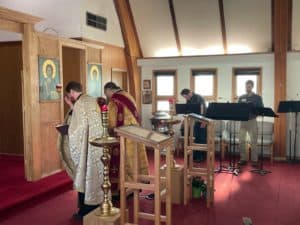 The discussion that followed Fr Athanasius and Mr. Grey Eagle’s presentations revealed that participants were moved and inspired by what they had heard. One of the Summit participants is also a Native American. He was only recently received into the Church at Holy Resurrection in Fargo. He confirmed all that had been said by Fr Athanasius and Bobby Grey Eagle.
The discussion that followed Fr Athanasius and Mr. Grey Eagle’s presentations revealed that participants were moved and inspired by what they had heard. One of the Summit participants is also a Native American. He was only recently received into the Church at Holy Resurrection in Fargo. He confirmed all that had been said by Fr Athanasius and Bobby Grey Eagle.
It also came out that His Eminence has made a study of Native American spirituality. He expressed his strong desire to meet with the Elders of these tribes. His request has since been given to Bobby Grey Eagle and Moses Chaska who, together with Fr Athanasius – himself a Jordanian whose culture also is tribal and very similar to the hierarchical culture of the Native American tribes – will convey His Eminence’s request to the Elders of their tribes. Informed of His Eminence’s desire to meet with the Elders of the Seven Tribes, Fr Athanasius said: “This is a seriously huge step for His Eminence to reach out to them. Our Elder meeting with their Elders. That’s how it’s done!”
The work of this first day of the Summit, given to laying out the ‘pipe-dream’ and bringing it into focus, concluded with reflections by the diocesan chancellor, Fr Paul Jannakos, and His Eminence. Fr Paul spoke to another principle of evangelizing in the way of the Church: the principle of suffering, the suffering of the Cross, and even martyrdom. He pointed to the suffering of St Herman of Alaska, and to the martyrdom of St Juvenaly and St Peter the Aleut as the model of Orthodox evangelism. Because St Herman identified with the native Alaskans as his own kin in Christ (like Bobby Grey Eagle referring to fellow Christians as our ‘relatives in Jesus’), and because he was faithfully present to them, he suffered with them in his Christian love for them.
 His Eminence pointed out that, in worldly terms, the original mission to Alaska, with all the resources of imperial Russia poured into it, failed completely. St Juvenaly and St Peter the Aleut were martyred – St Juvenaly by the very Alaskan tribe he was seeking to evangelize, St Peter by Christians. St Herman of Alaska was forgotten upon his passing for many years. And yet, His Eminence pointed out, we here today at this Summit are the fruit of their labors. Our Lord Jesus Christ is the ‘Lord of the harvest.’ We are His laborers. Our work is to labor in the field in obedience to His command. It is Our Lord who will raise up the harvest, even from the dead, in abundance, even a hundred-fold.
His Eminence pointed out that, in worldly terms, the original mission to Alaska, with all the resources of imperial Russia poured into it, failed completely. St Juvenaly and St Peter the Aleut were martyred – St Juvenaly by the very Alaskan tribe he was seeking to evangelize, St Peter by Christians. St Herman of Alaska was forgotten upon his passing for many years. And yet, His Eminence pointed out, we here today at this Summit are the fruit of their labors. Our Lord Jesus Christ is the ‘Lord of the harvest.’ We are His laborers. Our work is to labor in the field in obedience to His command. It is Our Lord who will raise up the harvest, even from the dead, in abundance, even a hundred-fold.
The second day was given to setting out practical steps to execute the vision that had been brought into sharper focus the day before. The day began by asking each participant to share how he or she was evangelized or caught by the Orthodox Faith. This was more than an ice-breaker. Hearing the stories of others gave participants to see how their being caught, evangelized, by Orthodoxy showed that the principles of Orthodox evangelism are not abstractions but living spiritual realities made incarnate in their own concrete experiences. This was the basis for the subsequent work of the conference, crafting an organic strategy for evangelizing the Dakotas; that is, in a way that is natural to the human soul made in the image and likeness of God.
 The beauty and meaning of Orthodox worship, made incarnate in the faithful themselves, is what participants described as that which drew them, in as many different ways as there were participants, to the Orthodox Church. What people want is not programs; they want to know how to pray, and true prayer is found in the living worship of the Orthodox Church. Not to believe in, but to become, this is the way of the Orthodox Faith as one participant expressed it. To become a partaker of the divine nature, theosis, this is what the Orthodox faith is all about, is how another participant expressed it. Divine grace that transforms, renews, heals and deifies, is poured out simply by practicing the daily and weekly cycles of Orthodox liturgical worship, is how another participant expressed it. Evangelization, that is, proceeds from and returns to the incarnate God on the altar of the Church, itself the visible symbol of the invisible altar of the human heart, drawing from the ancient Syriac Christian work, the Liber Graduum, or Book of Steps (Book XII).
The beauty and meaning of Orthodox worship, made incarnate in the faithful themselves, is what participants described as that which drew them, in as many different ways as there were participants, to the Orthodox Church. What people want is not programs; they want to know how to pray, and true prayer is found in the living worship of the Orthodox Church. Not to believe in, but to become, this is the way of the Orthodox Faith as one participant expressed it. To become a partaker of the divine nature, theosis, this is what the Orthodox faith is all about, is how another participant expressed it. Divine grace that transforms, renews, heals and deifies, is poured out simply by practicing the daily and weekly cycles of Orthodox liturgical worship, is how another participant expressed it. Evangelization, that is, proceeds from and returns to the incarnate God on the altar of the Church, itself the visible symbol of the invisible altar of the human heart, drawing from the ancient Syriac Christian work, the Liber Graduum, or Book of Steps (Book XII).
After the participants had all shared their stories, Fr Paul Hodge noted that they had identified at least some of the saints who we can be assured are overseeing and guiding this evangelical initiative under the omophor of our diocesan hierarch. For, in sharing how they had been evangelized, many of the participants referred to a particular saint they had come upon, who had inspired them and whose holy example had guided them on their journey to Orthodoxy. These saints included the Holy Theotokos, St Silouan, St Alexis of Minneapolis and Wilkes-Baare, St Isaac of Nineveh, St Seraphim of Sarov, St Sergius of Radonezh, St Herman of Alaska, St Peter the Aleut, St Xenia of Petersburg, St George the Great Martyr, St Irenaeus of Lyons, and St Ignatius of Antioch.
In the session that followed, Fr William uncovered what up to now has been hidden even as it is clearly visible: a territory lying between the two strong Orthodox centers of Winnipeg and the Twin Cities that has its own distinctive character. Recognizing and understanding this is of critical importance for crafting our strategic vision, he said. Fr Athanasius the day before had already referred to the unique character of this territory without naming it. He had said: “The hierarchy of many jurisdictions, with all due respect, has missed the important fact that this area is different than most areas in the US. In this region, people are religious, and pious, and are looking to serve God with all their God-given means.”
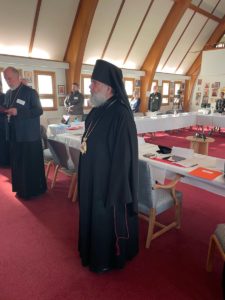 Fr William pointed out that the Orthodox centers of Winnipeg and the Twin Cities exert a gravitational pull that weakens as one moves farther away from these centers. For example, Holy Myrrhbearers (OCA) in St Cloud, only 66 miles from the city center of Minneapolis, already is just at the edge of the Twin Cities’ gravitational pull. Confirming the experiential import of this bit of geography, Fr William recalled that Dn Dana Bichler of Holy Myrrhbearers had shared with him that there are times when he feels close to the Orthodox community in the Twin Cities, but there are other times when he feels remote and isolated from them.
Fr William pointed out that the Orthodox centers of Winnipeg and the Twin Cities exert a gravitational pull that weakens as one moves farther away from these centers. For example, Holy Myrrhbearers (OCA) in St Cloud, only 66 miles from the city center of Minneapolis, already is just at the edge of the Twin Cities’ gravitational pull. Confirming the experiential import of this bit of geography, Fr William recalled that Dn Dana Bichler of Holy Myrrhbearers had shared with him that there are times when he feels close to the Orthodox community in the Twin Cities, but there are other times when he feels remote and isolated from them.
The parishes in this in-between territory are scattered and remote from each other, altogether outside the gravitational pull of either Orthodox center. As a result, they exist and live out their faith in isolation. To this, Fr Paul Wesche suggested, echoing Fr Athanasius, that it is a mistake to assume these parishes have the same needs as and a similar character to those in the major Orthodox centers. But this has failed to consider their distinctive character or to serve their real every-day needs. It has resulted in fostering insularity and exacerbating isolation and remoteness of these parishes from other Orthodox communities and from their hierarch. This is what has harvested the ‘stagnant Orthodoxy’ referred to in Fr Athanasius’ presentation, and, in many cases the extinction of Orthodoxy in this in-between territory referred to in Fr William’s earlier presentation.
Fr William’s ‘discovery’ of this in-between territory proved to be the strategic center that exerted its own gravitational pull on all the priorities for evangelization that the participants identified in the remaining sessions. It led the participants to ‘discover’ the practical and concrete foundation for the strategic vision the Summit was seeking to craft.
His Eminence saw immediately that this in-between territory needs to be established as its own ‘mission’ territory. It would embrace all the parish clergy in this territory, of all jurisdictions, who wish to be part of it, with the blessing of the respective hierarchs. This mission territory would be under the omophor of Archbishop Daniel; the willing clergy in this territory, with the blessing of their hierarchs, would form a ‘collegium’ of ‘mission clergy,’ a mission clergy brotherhood, working together in the common goal of evangelizing the peoples in this ‘in-between’ territory. The parish in each of the major towns in this territory – Bismarck, Minot, Fargo, Bemidji, Chisholm, St Cloud – would be the mission center of its surrounding region. The priests of these parishes would constitute a Mission Clergy Brotherhood. They would meet face to face regularly, on-line in between their face-to-face meetings, to share their assessments of the needs of each mission region, to discuss strategies for addressing the pastoral needs of each region, and above all, for fraternal support and encouragement. The district dean of Minneapolis would meet with them once or twice a year. The diocesan hierarch, and possibly the diocesan Chancellor, would be actively engaged in this mission work. He also would meet with them face to face at least once a year.
A larger Mission Council would be formed of both clergy and lay representatives from each parish, to identify strategies for bringing all the Orthodox in this in-between Mission Territory together for fellowship and worship, to build relationships with Orthodox faithful from other parts of the mission territory, and that would nurture them in the living communion of the Orthodox Faith, and strengthen them to be faithful in this day and age.
A Mission Fund would be established that would be administered by the Mission Clergy Brotherhood, under the omophor of Archbishop Daniel or the OCA diocesan hierarch of Chicago and the Midwest. This fund would be another financial resource to meet the needs of the parishes in this Mission Territory, to provide capital for needed repair and renovations, purchase of a temple enabling a community to move out of a rental or a building inadequate for their needs, facilitate outreach strategies – such as, for example, supplying quality Orthodox books for a coffee shop and bookstore that would front the temple but be a less intimidating point of entry for seekers and inquirers.
With such a ‘Mission’ territory within the Minneapolis Deanery in place, any priest assigned to any of the parishes in this territory would not be entering a backwater parish doomed to be forgotten as soon as the door closes behind him. He would be entering a clergy fraternity, composed of clergy from multiple Orthodox jurisdictions. Each priest would serve his own parishioners under the omophor of his own hierarch. But, with the blessing of his hierarch, he would be a ‘co-laborer’ with his fellow Orthodox priests in this Mission territory, all laboring in the common mission of evangelizing the souls in the region who are thirsty for the Church’s Fountain of Immortality.
Obviously, this model would necessitate cooperation at the hierarchical level as well. His Eminence expressed confidence that this would not be a problem, knowing as he does the other hierarchs in question. But it would also open the field ‘ripe for harvest’ to resources beyond any one jurisdiction and become a model that faithfully mirrors and makes incarnate de facto even if not de jure the reality of the Orthodox Church as the one, holy, catholic, and apostolic Church.
The Summit concluded with a Grand Banquet in the evening. It was actually just a potluck served by the faithful parishioners of Holy Resurrection in Fargo. But the ‘luck’ of the ‘pot’ was of such tasty quality that it was, in the opinion of everyone, de facto and not de jure, a Grand Banquet. But, in fact, the evangelical joy in which the participants came out of the two day Summit raised it even higher to the level of an Agape Feast.
Participants left the Summit excited, inspired, even renewed. “If we can follow through with what we have crafted,” said Fr Paul Wesche at the end of the Summit, “then we have every reason to be optimistic that the laborers in this field will become more plentiful, and the seeds of Orthodoxy will be sown to produce a field ripe for harvest by the Lord of the Harvest.”
The Spirit that suffused the proceedings of the Summit, the way in which everything fell into place, the strategic vision that came into view and the plan of action that rose from the vision, which no one could foresee before the Summit began, was everything His Eminence and the organizers had hoped it would be. All of this give reason for those who participated in the Summit to believe that what happened at the Summit was truly of the Spirit, that the strategic vision crafted by the participants felt good to them because it was also ‘good’ to the Holy Spirit. (Acs 15.28)

